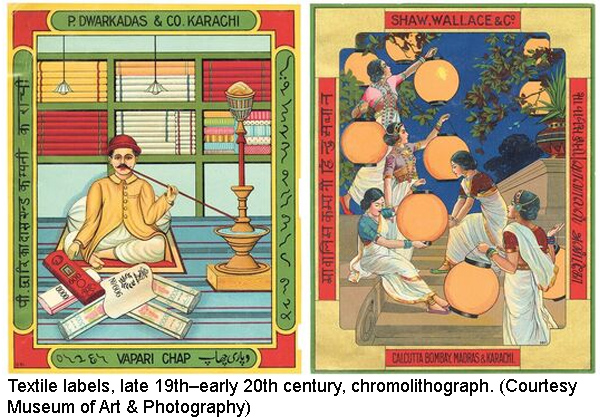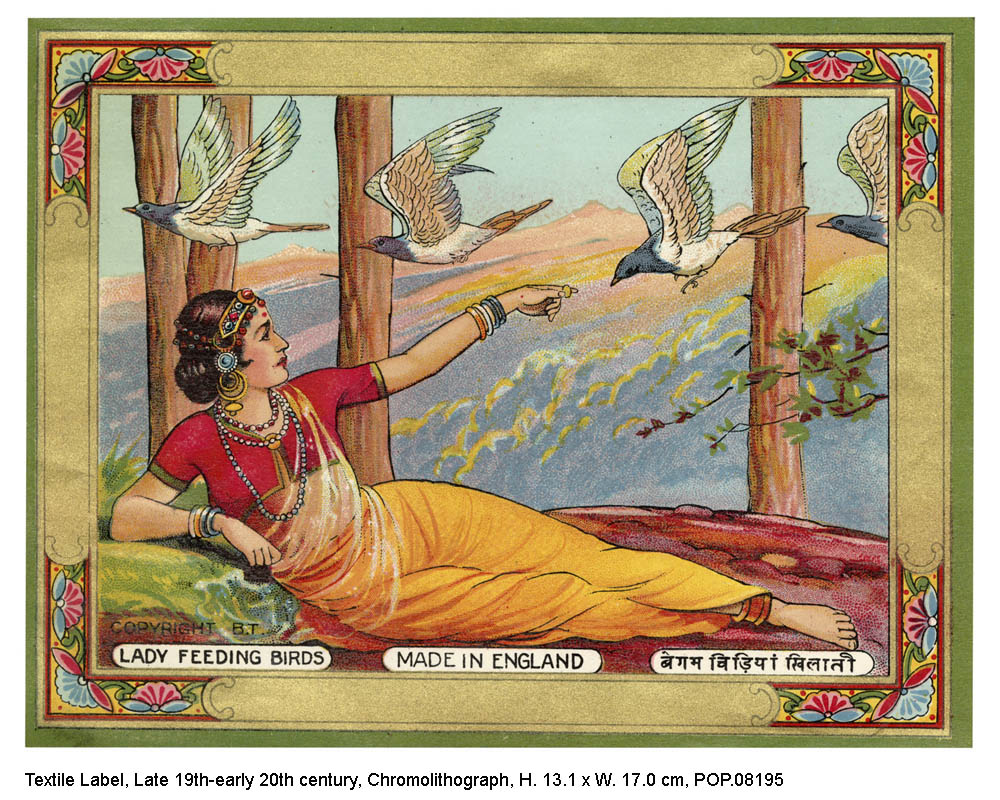
Category: INDIAN HERITAGE TEXTILE
Country: India
Region: South Asia
By Shalini Umachandran
29th March 2025
COURTESY MUSEUM OF ART & PHOTOGRAPHY
Textile labels, late 19th–early 20th century, chromolithograph.
There’s an uncanny resemblance between a work of art shown at Bengaluru’s Museum of Art & Photography last year and one at its current Ticket Tika Chaap: The Art of the Trademark in Indo-British Textile Trade. In the folio (part of last year’s Book of Gold show) from the luminous 17th century Kanchana Ramayana, fine miniatures with gold leaf, Garuda listens to Kaka Bhushundi. In the current show, the same scene with all details of trees and birds is replicated but in a bright, printed chromolithograph at about a quarter of the size. While the oneof-its-kind folio was commissioned by the Benaras royal family, the copied, massproduced version served as a textile trademark label for a British mill, slapped on to a bale of cloth exported to India.
Tens of thousands of textile trademarks were registered in Britain in the late 19th and early 20th centuries, each requiring a unique visual. Much like today’s election symbols, objects like “ship”, “radiator” and “aeroplane” were quickly snapped up as British factories turned out millions of yards of cloth for export around the world. Label artists in England had to look far and wide to create elaborate trademark stickers. Their inspiration came from Indian miniature art, contemporary American painting, Indian and Greek mythology, augmented by generous imagination. On one label, in a bazaar setting, two elephants try unsuccessfully to rip apart a bale of cloth from Pudma Poplin even as regular business carries on. A Tata Sons label features an Athena-like figure on a chariot drawn by four tigers.

These labels were stuck on the topmost layer of the bolt of cloth, usually 60-100 yards per bale, and were known as shipper’s tickets, textile marks or tika, or just chaap, from the Hindi for “to stick” or “imprint”. The unique images helped the importer build a brand in the Indian market, where buyers were largely illiterate.
In the 19th century, Britain supplanted India as the world’s leading cotton cloth manufacturer, largely due to the Industrial Revolution. The India-focused imagery— from the fantastical to the religious to the realistic—indicates the race to win over Indian buyers. It’s a wealth of global business history spanning the textile, manufacturing, printing and shipping industries, all contained within marvellously idiosyncratic little stickers.
The show is largely silent on cotton’s role in colonial expansion, intellectual and cultural appropriation, and the effect of the East India Company’s practices on Indian weavers and traders, preferring to focus on the artistic aspect. Without the historical context, the labels are reduced to mere objects of curiosity. To walk through the exhibits is to be reminded of the millions upon millions of bales exported to India from Manchester, which itself had built its machines for spinning and weaving with skills and know-how copied from Indian handloom weaving and hand-printing techniques. A combination of high tariffs, fixing of prices and use of brute force by the British from the 1700s onwards aided Manchester’s dominance of the cotton trade. Some labels casually display the backbreaking labour of Indians that enriched British mill owners. One ticket shows half-a-dozen Indians weighed down by massive bales of cloth, walking from England to India along a bridge composed of the letters of the name Shaw Wallace & Co.
This was before the Swadeshi movement and the boycott of British-made goods took hold.This exhibition of small but significant artefacts is a reminder of just how large a market India was for the British, even as they cynically capitalised on its natural and human resources.
On till 2 November at Museum of Art & Photography, Bengaluru, 10am-7pm.
Courtesy: livemint.com & map-india.org
Copyrights © 2025 GLOBAL TEXTILE SOURCE. All rights reserved.